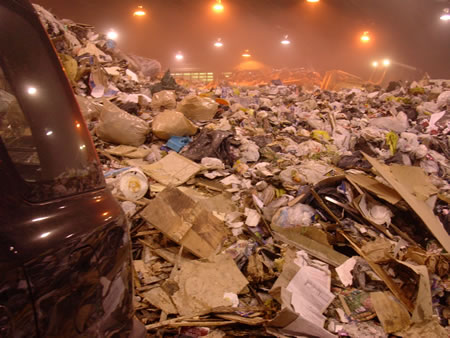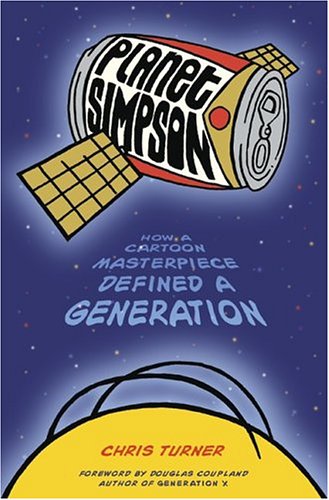Here’s a video from last night’s Kickass Karaoke at the Bovine Sex Club:
Kickass Karaoke host Carson T. Foster usually strips down to his skivvies by the end of the night.
Here’s a video from last night’s Kickass Karaoke at the Bovine Sex Club:
Kickass Karaoke host Carson T. Foster usually strips down to his skivvies by the end of the night.

The trash pile at Bermondsey Transfer Station.
Accordion City — in addition to adding a new “green bin” into which compostable trash should go — has switched to a once-every-two-weeks garbage collection schedule. This is workable for my household most of the time, except for a couple of weekends ago, when a combination clean sweep of the house and king-sized birthday party attended by about 100 left me with ten bags of trash and six bags of recyclables. I had one week to wait until trash pick-up time and already the raccoons had made a mess of the garage (where the bags were being stored) twice.
My old tactic of taking the bags to Spadina Avenue, the busy street half a block west of my house, and tossing in my refuse with the trash of some business would no longer work. The garbage collectors will now only collect specially marked yellow City of Toronto bags, which businesses have to procure (I have no idea whether these are free or cost some nominal fee). I remember grumbling to myself “Rat bastards! I want my Tragedy of the Commons back!”
I decided to look at the Toronto trash and recycling calendar and found that a number of 24-hour dumps were scattered throughout the city. The schedules are such that residential trash can’t be brought in during business hours on weekdays; in fact, the ideal time to bring in your house trash is between midnight and 8 a.m.. For a night owl like me, that’s nothing.
I figured that the easiest place to get to that would also take trash and recyclables would be the Bermondsey Transfer Station, which is just off Eglinton Avenue, just east of the Don Valley Parkway. With the CR-V back seats folded down and the cargo area carpeted with newspapers and stuffed with bags of trash and recyclables, I motorbootied to the dump.
Bermondsey Road is a nondescript street filled with buildings devoted to light industry. The Bermondsey Transfer Station is easy to miss; from the road, all you see is a City of Toronto sign bearing the station’s name. The driveway led to a toll-booth-like station with a truck scale. I was instructed to drive onto the scale and hand over a $10 deposit, after which I was given a sheet of paper and told to drive down the road and into the main building.
An old guy with a long grey beard manned the station at the main building. He took the paper that the guy at the guard station had given me and directed me to back my car near the large trash heap.
The main building is a concrete cavern housing what looks like a minature air traffic control tower, bulldozing equipment and a hill made entirely of trash, whose height varied from two to five times that of my car.
I added my trash bags to their pile, after which I took some pictures and even shot some video of a bulldozer in action. I then returned to the “toll booth”, where I stopped the car on the exit scale and got $8 of my $10 deposit back.
Getting rid of the recyclables required a return trip to the “toll booth”, where I got another piece of paper to hand to the old guy at the building. He directed me to a smaller pile in the back corner of the building, where I unloaded my clear bags of recyclables. Unlike trash, there is no charge for getting rid of recyclables.
Bermondsey is one of seven dumps in the city [PDF file]:
There you go: a how-to on getting rid of excess trash. Who says blogs don’t tell you anything useful?
It may sound strange, but I recommend travelling to the dump, if only to get a sense of the waste material we produce (and often send to Michigan).
Bonus reading material: National Post writer John Geiger whines about having yet another container into which to sort trash, “Chief Dan George-type philosophy espoused by the solid waste bureaucracy” and about how our current trash situation is the fault of the “garbage bureacracy’s” bungling in the search for a new landfill. It’s all “I want my Tragedy of the Commons back!” and “What have future generations ever done for me?”

Mmmm…droogie. A Clockwork Orange-inspired burlesque routine from Skin
Tight Outta Sight’s Halloween show at the Gladstone Hotel.
Meryle informs me that Skin Tight Outta Sight will put on a free —
that’s right, free — burlesque show at the Bovine Sex Club (542 Queen
Street West, just eats of Bathurst) at 11 p.m.. Jon Stewart’s
illegitimate evil son, Mysterion the Mind Reader, will be hosting the
event and doing some mind and magic tricks between burlesque acts.

Mysterion the Mind Reader will be hosting the event. Even Bovine “regulars” think Mysterion’s a bit of a freak.

Remember how I wrote about how Factory Direct Computer Outlet was selling refurbished 10 gig iPods for CDN$279? From now until November 17th, once you factor in a CDN$40 rebate, they’re now going for CDN$199 (according to xe.com, that’s US$166.17).
Here are two more videos from Friday’s event, Mysterion the Mind
Reader’s Haunted Hotel Halloween Hoopla. Both are of the “psychobilly”
local band The Matadors. The first is of their audio-animatronic
skeleton introducing them; the second is a snippet of their rip-roarin’
performance.
These files are included as attachments, so if you’re reading this on a web page, click here to get them.
Those of you reading with aggregators that can “see” RSS 2,0 enclosures
should be able to grab them — I think. Let me know what you see!
For your entertainment, I present to you a number of movies that I shot
at Friday’s event, Mysterion the Mind Reader’s Haunted Hotel Halloween
Hoopla. The movies included with this entry are attachments; click here
to download them.
They are:
Meryle performing her number.
I’m going to a launch party at the Drake Hotel for my friend Chris “Turner” Turner’s first book, Planet Simpson.

Chris is a friend of mine back from our days at Crazy Go Nuts University, where he and I were both DJs at the engineering student-run Clark Hall Pub. He later went to become a freelance writer, submitting some of the best pieces for the late great Shift magazine (a creation of Canadian Gen-X pundit and CBC fixture Evan Solomon) and later, Time magazine. Wendy and I attended his wedding in January.
I have no idea if the party is an open or closed one; if you’re in the neighbourhood, drop by and check it out!
As for the book, it’s quite thick (450 pages!) and attempts to balance popular appeal with scholarly rigor.
Booklsut has this to say:
While the book will hold on to every reader, Turner’s dense academic
feel towards the end may feel like homework, and will definitely place it in
university bookstores for next semester. Some of the chapter subtitles have
a textbook feel, for example: “Journey to the Center of the Simpsons:
Self-Awareness, Self-Reference, Self-Parody, and the perfection of the Postmodern
Aesthetic.” But there is so much to this book that everyone will love
it.
The cultural studies canon has recently expanded to include dissections of
tv shows such as Buffy the Vampire Slayer, The Sopranos and
Sex and the City. But Planet Simpson trumps them all.
Turner scored a coup (hah!) by landing Douglas (“Generation X“) Coupland to write the foreword. An excerpt:
If this book were to have an alternative title, it would most likely
be, How to Cook for Forty Humans. If that makes no sense to you,
chances are you probably haven’t read this far anyway. If it does make
sense, you’ll understand the treat that’s coming your way just a few
pages from here.
I’m looking forward to sharing a Guinness with Turner tonight. Congrats on getting published, dude!